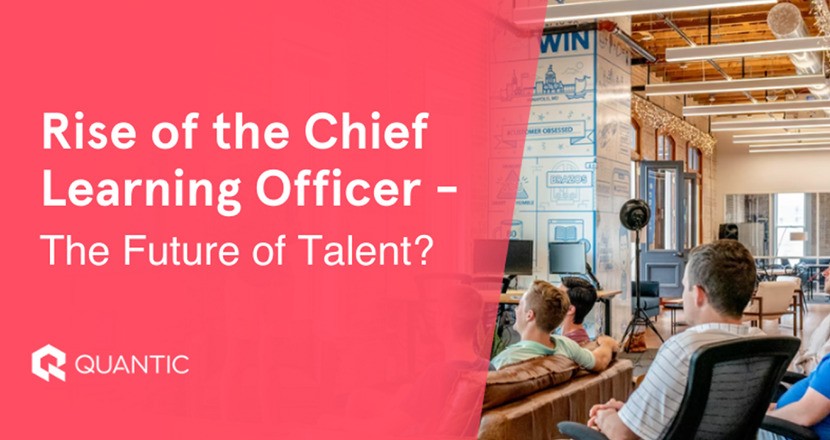CAREER PLANNING
Rise of the Chief Learning Officer — The Future of Talent?
In 1989, Jack Welch, CEO at General Electric, endorsed Steve Kerr to the position of Chief Learning Officer. His job was to ensure employees were content, developed, engaged, and retained.
Three decades later, businesses worldwide have faced unimagined learning disruption.
Many organizations have embraced “on the job” learning that uses instructor-led training technology to empower workers for problem-solving.
However, while incremental learning delivers, it doesn’t provide the necessary skills shift needed by today’s workforce.
The future of work demands a labor force that will have to tackle problems in real time and understand “what’s next.”
In its 2020 edition, the Chief Learning Officer Magazine ran a report called “Learning State of the Industry,” where it stated that learning leaders will be better fused into organizational talent management going forward.
Today, you’ll understand the CLO, and what prepares them to step up as talent managers in the organizations they represent.
This will also be practically presented through CLO interviews conducted and presented below.
What Is a Chief Learning Officer?
Chief Learning Officers are also called Directors of Learning and Development or Chief Knowledge Officers. They occupy a C-suite position and either report directly to the CEO or the HR Officer.
They’re responsible for developing the organization’s learning culture and ensuring the vision is kept alive throughout all levels. They see to it that the company’s workforce is skilled and knowledgeable.
What Does a CLO Do?
In today’s rapidly changing business landscape, the CLO comes in to reshape an organization’s learning capability.
This is a diversion from the traditional road, where they used to manage large physical training spaces, which often took up a great deal of time and energy.
Consequently, the CLO is responsible for initiating strategic initiatives aimed towards life-long learning. They handle instructional strategies, learning technologies, the development of scientific learning methods, and professional development activities.
The CLO’s role now represents a mix of social, informal, and formal management of content across several platforms, which in turn helps employees learn flexibly.
In addition, Chief Learning Officers are responsible for:
- Formulating an organization’s learning and education process by coming up with learning strategies and managing their execution, according to the organization’s goals.
- Managing knowledge by strategically identifying and maintaining infrastructures such as libraries and knowledge bases. They also create a feasible learning environment by bringing in career coaches and skilled trainers.
- Coming up with effective strategies for training through identification and assessment of training needs. He/she begins at the managerial level, where the main target is coordination and training. Later, lower-tier employees are trained using the most effective methods.
- Instituting the latest learning technologies that align with business goals, practices, systems, and operations across the organization’s varied business units. He/she crafts a roadmap to keep learners interested in learning while measuring outcomes.
- Informing shareholders of the importance of learning. This includes the CEO (whom they probably report to) as well as external and internal audiences, and the board of directors.
Chief Learning Officer’s Crucial Role and Responsibilities
As a senior executive, the CLO is responsible for employee development through learning, in line with the company’s overall strategic roles.
The CLO can take on a variety of names, like:
- Head of Learning
- Director of Learning and Development
- Learning Manager
- Senior Manager, Learning and Development
Some organizations view the CLO as an expert responsible for talent management and people development. They reinforce learning organizations by growing employees to be self-actualized individuals.
With respect to reporting, some organizations maintain a straight accountability lane between the CLO and the CEO, while others add a layer between the two. Either way, there’s always a form of direct visibility between the CLO and the organization’s top management.
Con Sotiditis, former L&D executive at Australian Taxation Office, puts it this way:
Research conducted by Chief Learning Officer reveals that of those interviewed:
- 27.8% report to the Human Resource Office
- 25.8% report to the CEO
- 6.9% answer to the Chief Operating Officer
- 2.6% report to the Chief Talent Management Officer
CLOs should be on the constant lookout for the company’s goals, and align learning strategy with the focus and mission.
For example, if the company seeks to add more sales to its bottom line, the CLO will be responsible for empowering the sales and marketing department with tools and methods that address contemporary marketing challenges and how to sell better to their niche.
Demand for CLOs is brought about by the current changing nature of work and the workforce. Reskilling and upskilling have led to new power skills such as resiliency, communication, adaptability, and agility.
In response to these changes, the CLO comes in strongly as a business leader responsible for providing computable learning solutions that are at par with business goals.
Why Chief Learning Officers Are the Future of Talent
The CLO role remains focused on the mission of applying human science to the workplace. This means that human beings are taken to be social, adaptive, and self-organizing. He/she, therefore, helps in supporting, nurturing, and enabling employees.
However, a lot has changed since Mr. Welch conceptualized the role.
Today, the CLO has the duty of integrating learning operations with company goals.
The Harvard Business Review coined a term in 2020: the Transformer CLO.
In this new position, the CLO has a goal of helping employees develop a mindset for growth, consequently reducing the chances of turnover and attracting top talent necessary to push the organization forward.
Furthermore, transformer CLOs must embrace digital transformation. Digitization means vetting and adopting a blend of tools/technology that makes learning possible online and in-person.
21st-century CLOs are responsible for the following changes:
- Learning goals, which help employees gain skills that help them perform well now and in the future. Digital thinking and instruction takes the center stage in the entire process.
- Learning methods that involve just-in-time delivery. This means that training should be immediate, experimental, peer-based, and fully atomized for the task at hand.
- Learning departments — making them more strategic, nimble, and agile. Departments team up to spearhead employee performance, capabilities, and culture.
This seems to be the best time this transformation is needed.
Automation is a hanging threat in US employment. 47% of US employees are low-paid workers at risk of losing their jobs due to automation.
Consequently, 88 million working employees need a skills shift to stay relevant, and 64 million don’t have a college degree.
Women are, sadly, generally underrepresented in many such leadership development programs, and CLO leadership development programs are no exceptions.
A recent Zippia report shows that 57.5% of CLOs are men, compared to 38.0% being women, as illustrated below:
There’s also a corresponding disparity in their earnings, with men earning more than women.
Virtually all sectors can accommodate CLOs. The table below provides a breakdown in percentage of the top 5 industries:
| Industry | Description | % Hired |
| Tech Industry | Software firms, big data analytics, and IT consulting companies | 16 |
| Factory and manufacturing | Food processing plants, beverage companies, and automakers | 12 |
| Health | Healthcare and life sciences, for didactic information analysis | 11 |
| Finance | Banks and insurance companies | 8 |
| Non-profit | Collaborate with external trainers and key partners and funders | 6 |
Table courtesy of zippia
Chief Learning Officers Love Quantic
A chief learning officer is a key player in an organization, and Quantic School of Business & Technology offers the best programs for CLOs.
CLOs who train at Quantic boast the best education experience where they undergo an interactive learning session to gain marketable skills from the available degree programs.
At Quantic, we believe that learning and knowledge are the driving forces behind adaptability. Furthermore, we encourage team learning, which entails training your workers on a large scale.
Learners who’ve been trained in this fashion can quickly convey lessons learned from a scenario. This empowers a complete team to readjust.
Active Learning supplements team learning and ensures students take an active approach to coursework. That’s a more cost-effective and time-efficient way to teach your entire crew.
Book a call to educate your workforce collaboratively and at scale.
Chief Learning Officer Conferences
CLO conferences are opportunities to meet, grow, and connect with like-minded professionals. You stand to benefit from the workshops, presentations, and networking opportunities.
You might be interested in a few listed below:
- CLO Symposium 2021: Dubbed “Resilient, Fluid, and Fearless: The Future of Learning,” this conference is virtual and will take place between October 5th and 6th, 2021.
It involves case studies that show how organizations have pivoted and transformed during hard times, using innovation and strength. - Training Industry Conference and Expo: Nicknamed TICE, this online event brings together minds to discuss challenges and solutions in leading L&D teams. It takes place between September 28–30, 2021.
This corporate learning event helps you network with others in an attempt to find solutions to Learning and Development (L&D). - Learning Technologies Brings together top performers in learning from around the world. It recognizes enthusiasm, passion, and commitment to learning technologies around the world. Their awards ceremony takes place on November 17, 2021.
- Corporate Learning Network Helps you benchmark with the top guns in Learning and Development. It involves the use of L&D to future-proof and grow organizations. They have a conference running every year.
How to Become a Chief Learning Officer
As a chief learning officer, you’ll work in a variety of organizational settings and industries, so there isn’t one particular educational path to CLO certification or licensure.
Chief Learning Officer Education
A CLO typically needs a bachelor’s degree in subjects like human resource management and business administration, though a professional certification and/or a graduate degree boost employment prospects.
A certification shows an employer that an individual has learned specific skills and met course requirements.
Expertise in information technology is an added advantage since many L&D portals are computer-based. Other topics such as behavioral psychology, educational philosophy, and instructional design have also proven beneficial.
The graph below shows a breakdown of CLO degree levels for those currently in practice.
A cross-section of employers prefer applicants who have professional certifications from industry organizations.
These organizations offer leadership development and learning design, aimed at enhancing career development. Such organizations include the American Society for Training and Development.
A CLO’s career path involves working with people. A recent study reveals the following about CLOs:
- They spend at least seven years working in other careers before taking up the position of CLO. This normally includes positions such as:
- Vice President (five years)
- Director of Learning and Development (four years)
- Managing Director (three years)
- Editor(five years)
- Their top fields of study include the following:
| Major | Number of CLOs |
| Bachelor of Arts | 24.4% |
| Bachelor of Science | 16.6% |
| Master of Arts | 10.4% |
| Master of Science | 9.1% |
| Doctor of Philosophy | 9.1% |
| Master of Business Administration | 8% |
| Other | 5.4% |
- Subsequent positions for CLOs include:
- Vice President (three years)
- Executive Director (three years)
Chief Learning Officer Resume
A CLO’s resume should showcase the relevant skills and work history that aligns with the job at hand. Exposing relevant achievements will help you stand out.
Follow the steps below to create an appealing resume:
- Format your resume: Make sure it is clear and easy to scan and read. Ensure your contacts are prominent. Also, use bold and clear headings, and present your portfolio items in chronological order.
- Craft a professional objective or summary: Use a resume objective if your CLO experience is less than two years. Otherwise, create a resume summary.
- Begin at your current job: List your work experience from the most recent position occupied. Start with the title, then follow it with employment dates, the name of the organization, and your experience in five bullet points.
- Add your education level and coursework: This should be relevant to the position and stand out as much as possible.
- Proofread your resume: Look out for spelling mistakes, grammar, and other issues. Ask someone else to check it out as well.
- Attach a cover letter: Give a powerful and eye-catching introduction, executive experience, and relevant expertise. Don’t forget your skills and achievements. Finish off with an impressive statement.
Chief Learning Officer Salary
According to the US Bureau of Labor Statistics (BLS), training and development managers earned an average annual wage of $115,640 in 2020. There is an expected growth in the field between 2020 and 2030, which is higher than the average for all occupations.
| Quick Facts: Chief Learning Officer Annual Payment | |
| Medium Pay (2020) | Annual: $115,640 Hourly: $55.60 |
| Entry-Level Education | Bachelor’s Degree |
| Former Work Experience | Five years and more |
| On-the-job training | Nil |
| Total Jobs in 2020 | 42,100 |
| Job Direction, 2020–2030 | 11% (exceeds average) |
| Employment shift, 2020–2030 | 4,500 |
A Zippia research study has further proven that masters and MBA holders command the highest average annual salary, which is around $144,658. Please refer to the comparison graph below:
It takes time and effort to create a motivated workforce that uses learning to solve today’s challenges. You need a solid Learning and Development culture that provides your team with the skills they can learn and use to meet your organization’s objectives.
At Quantic, we are strong believers in learning as the strongest driver to up-skilling. Furthermore, our curriculum encompasses team learning, which helps train your workforce at scale. In this way, learners can share lessons learned, thereby benefiting themselves and the entire team.
Active Learning is Quantic’s method. It places the student at the center of the digital learning experience. They only move ahead after properly mastering the previous skill, and give feedback every eight seconds of going through our video course.
Quantic offers a collaborative framework to help your organization’s employees learn quickly and efficiently.



